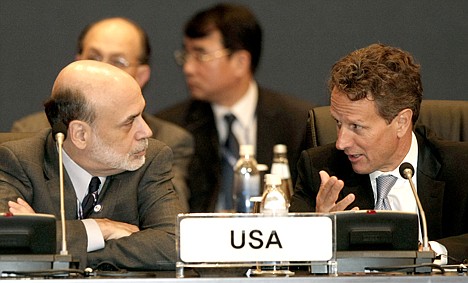Federal Reserve now the only stimulus game in town
WASHINGTON - Any more stimulus spending by President Barack Obama and Congress is dead, after this week's election blowout by the Republicans. Yet, Federal Reserve Chairman Ben Bernanke's "Hail Mary" pass to pump $600 billion into the banking system is really stimulus spending under another name.
The Fed won't be spending taxpayer money or borrowing from China. It will be doing the electronic equivalent of creating dollars out of thin air. The central bank will then use the new money to buy longer-term government bonds. The Fed's plan will initially increase the supply of dollars held by banks, hopefully spurring more lending.
If all goes according to Bernanke's script, the bond purchases - $75 billion a month for eight months - should force down yields, taking with them interest rates for homeowners, consumers and businesses. It should also help make U.S. goods more competitive overseas and keep alive a stock market rally that began in August.
All of that should boost economic growth, help the ailing housing market and encourage more hiring.
It may not work. And there are risks.
Printing so much new money could lead to runaway inflation down the road. Lower interest rates could also produce speculative bubbles in the price of oil and other commodities and in risky high-yield investments. It could also take pressure off the White House and Congress to confront the long-term deficit crisis.
Thomas Hoenig, the president of the Federal Reserve Bank of Kansas City, calls it "a pact with the devil." He was the only dissenter in the Fed policy committee's 10-1 vote for the Fed effort, also known as quantitative easing.
The bold move - carefully choreographed since last summer - came as the central bank was starting to run out of arrows in its quiver. Its main weapon for revving up or slowing down the economy is adjusting short-term interest rates. But, given the magnitude of the downturn, the Fed has held those rates at near zero since December 2008.
Fed leaders figure the $600 billion bond-buying program will provide a modest boost to the economy over the next year, but they acknowledge that the jobless rate, now at 9.6 percent with nearly 15 million unemployed, will stay high. And it could even rise in the next few months.
It is the Fed's second experiment with buying bonds on the open market. From December 2008 to this past March, it bought $1.7 million in Treasurys and mortgage-backed securities. But since then, the recovery has faltered.
Fed officials calculate that Wednesday's action will be the equivalent of a three-quarters point reduction in the Fed's benchmark interest rate, the rate that banks charge each other for overnight loans. Normally, a cut that size would spur economic growth. But that option is obviously unavailable, since the rate is already near zero.
Republican gains in Congress make it far less likely that the Obama administration will be able to embark on new programs to revive growth through government spending. Obama's $814 billion stimulus was roundly demonized by Republicans on the campaign trail and it found few boosters among running-scared Democrats.
So Bernanke - a Republican himself, first appointed to the post by President George W. Bush - stepped in. Unlike Obama, he doesn't have to get Congress' permission to spend money to stimulate the economy or face voters' wrath.
Just don't expect him to call it "stimulus," even though that's the clear intent.
"The Federal Reserve cannot solve all the economy's problems on its own," Bernanke wrote in an essay in Thursday's Washington Post. But he added that the Fed has an obligation to promote increased employment and sustain price stability. "Steps taken this week should help us fulfill that obligation," he wrote.
The Fed's bond-buying strategy is a little like pushing on string. There's no guarantee what will happen.
"My own view is that it won't accomplish a lot," said Nigel Gault, chief U.S. economist at IHS Global Insight. "Essentially what you're doing is shaving a little bit off long-term interest rates which already were very low," Gault said.
In late trading Thursday, the yield on the benchmark 10-year Treasury note fell to 2.47 percent from 2.57 percent the day before.
With its efforts to stimulate growth, the Fed's balance sheet now stands at $2.3 trillion, nearly triple what it was before the recession. Adding the new bond holdings will push it to nearly $3 trillion.
The Fed could find it difficult to unwind its bond-buying spree.
"It's like the Fed developed a space rocket and is focused on getting to the moon but hasn't figured how to get back to Earth," said Mark Williams, a lecturer on finance and economics at Boston University and a former bank examiner for the Fed.
Bernanke says those fears are overblown. He expresses confidence the Fed has the tools to rein in its stimulus when the time comes.
Mark Zandi, chief economist at Moody's Analytics, suggested benefits of the Fed program "should start to flow to the economy as we move into the next year." He believes they outweigh the risks.
Lower interest rates will reinforce mortgage refinancing, encourage more home sales, and make stocks a more attractive investment, Zandi said. "Higher stock prices are key to business hiring and investment decisions. And high-income households are very focused on their nest-eggs," Zandi said.
"Increases in stock values makes them more willing to go out and spend," he added.
The broad U.S. stock market has rallied since the Fed first hinted at its course of action in August, rising to its highest level in two years.

